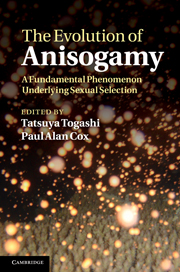Book contents
- Frontmatter
- Contents
- Contributors
- Introduction: The evolutionary mystery of gamete dimorphism
- 1 The origin and maintenance of two sexes (anisogamy), and their gamete sizes by gamete competition
- 2 The evolutionary instability of isogamy
- 3 Contact, not conflict, causes the evolution of anisogamy
- 4 Nucleo-cytoplasmic conflict and the evolution of gamete dimorphism
- 5 Adaptive significance of egg size variation of aquatic organisms in relation to mesoscale features of aquatic environments
- 6 Gamete encounters
- 7 Evolution of anisogamy and related phenomena in marine green algae
- Index
- References
4 - Nucleo-cytoplasmic conflict and the evolution of gamete dimorphism
Published online by Cambridge University Press: 19 May 2011
- Frontmatter
- Contents
- Contributors
- Introduction: The evolutionary mystery of gamete dimorphism
- 1 The origin and maintenance of two sexes (anisogamy), and their gamete sizes by gamete competition
- 2 The evolutionary instability of isogamy
- 3 Contact, not conflict, causes the evolution of anisogamy
- 4 Nucleo-cytoplasmic conflict and the evolution of gamete dimorphism
- 5 Adaptive significance of egg size variation of aquatic organisms in relation to mesoscale features of aquatic environments
- 6 Gamete encounters
- 7 Evolution of anisogamy and related phenomena in marine green algae
- Index
- References
Summary
CYTOPLASMIC SELECTION MAY CAUSE NUCLEO-CYTOPLASMIC CONFLICT
Several authors have noted that the mixing of cytoplasm following gamete fusion may increase the potential for spread of deleterious cytoplasmic variants through a sexual population (Grun, 1976; Eberhard, 1980; Cosmides and Tooby, 1981). This argument assumes a lack of precise control of intracellular replication and subsequent lack of segregation of the cytoplasmic DNA at gametogenesis. The replication and transmission of nuclear genes is tightly regulated, ensuring no segregation of alleles at mitosis and a fair meiotic segregation in heterozygotes. Thus, in the words of Birky (1983), the nuclear genome is “stringent.” In contrast, cytoplasmic genomes are “relaxed”: multiple cytoplasmic genomes populate each cell; they can be replicated different numbers of times during a cell cycle (Clayton, 1982) and can be differently transmitted to daughter cells. Throughout this chapter I focus primarily on mitochondria as examples of obligate cytoplasmic organelles, but similar reasoning applies to other cytoplasmic entities like plastids in plants and vertically transmitted endosymbiontic bacteria. The relaxed regulation of mitochondrial replication and segregation increases the scope for within-individual selection among mitochondrial genomes. This may possibly result in the evolution of selfish mitochondrial variants that are able to acquire a within-individual transmission advantage while being harmful to the host organism. A transmission advantage of a selfish mitochondrial mutant could result from superior competitiveness in heteroplasmic cells, for example due to a higher replication rate resulting in numerical over-representation in zygotes.
- Type
- Chapter
- Information
- The Evolution of AnisogamyA Fundamental Phenomenon Underlying Sexual Selection, pp. 111 - 130Publisher: Cambridge University PressPrint publication year: 2011
References
- 12
- Cited by



